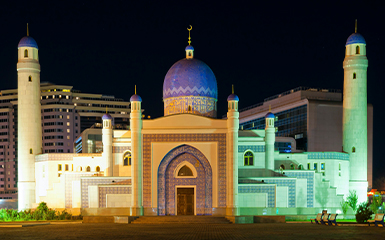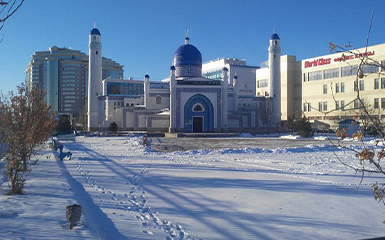Aisha-Bibi mausoleum
Aksu-Zhabagly
Aktau
Almaty
Altyn-Emel
Arystan Bab
Atyrau
Azret Sultan
Babaji Khatun
Bayanaul
Begazy necropolis
Beket-Ata Mosque
Almaty Lake
Lake Burabay
shakpak-ata-cave
Charyn Canyon
Hilvet mosque
Hodja Ahmad Yesevi
Holy Cave
Kaindy
Kapchagay
Karakhan mausoleum
Karkaraly
Kizhel Kensh
Kolsai Lakes
Korgalzhyn
Balkash lake
Lake Shaitankol
Jochi Khan
Karasai and Agyntai Batyr
Kozy Korpesh and Bayan Sulu
Mashkhur Zhussip Kopeyuly
Rabiga Sultan Begim
Kenty-Baba
Nomad Fortress
Nur-Sultan
Ruins of Otrar
Ruins of Sauran
Shopan-Ata
Shymbulak
Sultan-Epe
Tamgaly Gorge
Tamgaly-Tas
Alasha Khan
Torysh
Zhirensakal Peak
Employer Mikhail Guriev in 1615 asked Tsar Mikhail Fedorovich for a decree on the monopoly of catching sturgeon in the Ural mouth, but to protect it from raids, he had to build the town fortification and deliver red caviar to the tsar. Atyrau's origins can be traced back to the 1640s. Initially, it was a fortified city located at the mouth of the Yaik River, from which it flows into the Caspian Sea. Yaik finally was renamed by Catherine II and became the Ural River. Russian merchant Gury Nazarov, who first started fishing on the river and extracted Emba oil, founded the wooden fortress as Nizhny Yaitzky Gorodok (literally, Lower Yaik Fortress) at the mouth of the Yaik River in 1645. Cossacks plundered the castle, and the Guriev family rebuilt the castle by using stone (1647-62). As a result, from 1708 to 1992 the city was known as Guryev in honour of the founding family. The castle gradually lost its strategic importance and was demolished in 1810. The city began to grow in the 1930s when a fish cannery and Balykshi residential area was built. Later, II. During World War II, many industrial plants were transferred here. An oil and gas processing plant and a residential district Zhilgorodok were built. In October 1991, the city government of Guriev decided to change its name to Atyrau. The word "atyrau" in the Kazakh language means the place where the river empties into the sea. The city of Atyrau was founded on the bank of the river, but today it is 25-30 km from the river. Thus, the Ural is said to have divided Atyrau into two parts, Europe and Asia. Initially, the city was built mainly on the European side. Oil development in the city began in the late 19th century and is today the main industry in Atyrau.
Atyrau’s Golden-Domed Russian Orthodox Church has been around for more than a hundred years since 1888. The main entrance of the building is located at the west end. This symbolizes the believer from the darkness of sin (West) to the light of truth (East). The onion-shaped round shape on the roof of the church is particularly suitable for the snowfall that is common in the area.


